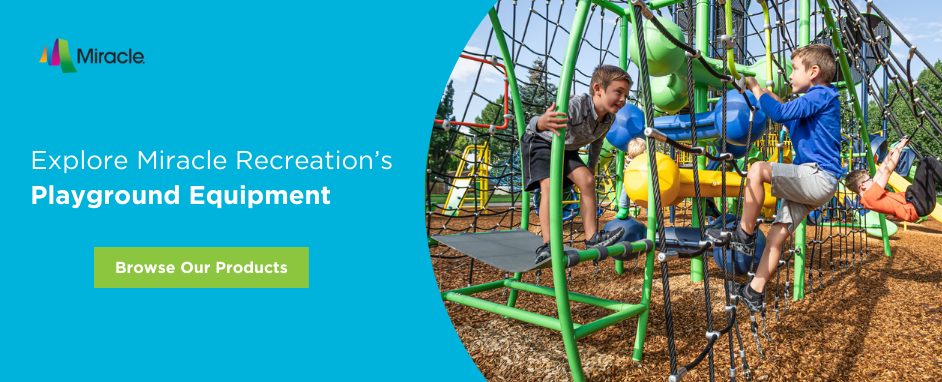Guide to Choosing Playground Equipment for Ages 2-5
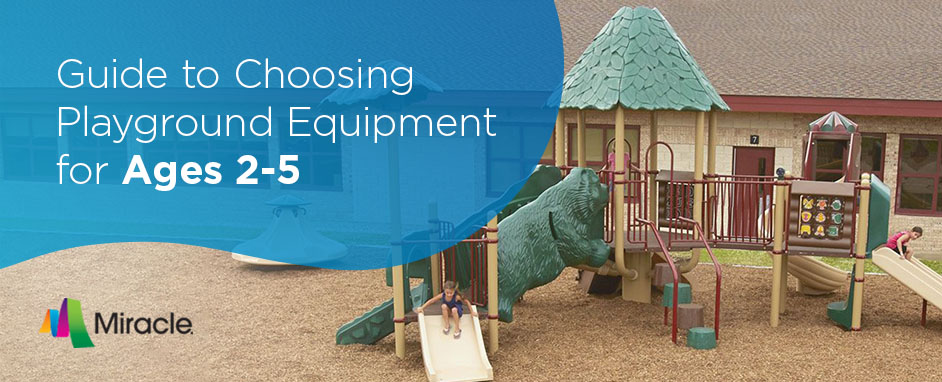
Playgrounds are communal spaces that enable creativity, imagination and development. However, you might notice that a playground built for elementary or middle-school kids is different from those used in preschools or daycares. This is because there are varying physical, social and cognitive abilities in different age groups.
For preschoolers ages 2-5, playground equipment must be useable and accessible for their height and blossoming skills. There are endless benefits to implementing a fun, inspiring environment for preschoolers to learn the power of innovation. With age-appropriate playground structures and activities, young kids can discover new possibilities, build up their strength and connect with others.
Read the full article or jump to a specific section:
- What Should Playground Equipment for Preschoolers Do for Them?
- What Is Age-Appropriate Playground Equipment for Ages 2-5?
- Preschool Playground Equipment Options
- How to Select Playground Equipment for 2 to 5-Year-Olds
- Other Considerations for Selecting Preschool-Level Playground Equipment
What Should Playground Equipment for Preschoolers Do for Them?
Between the ages of 2 and 5, young kids are quickly growing and adapting to their environment. At this stage, they learn how to speak, behave, play, move and interact with those around them. Some of the most important skills and milestones that preschoolers are developing during this age include:
- Social and emotional: Preschoolers exhibit a developing personality and growing imagination. They are also improving their social interaction and learning to engage in positive relationships. Playing outside can help with self-regulation, self-confidence and cooperating with others.
- Cognitive development: Playing outside can improve the foundations of learning and problem-solving. The routine of playtime can also help preschoolers adhere to a schedule and learn what to expect. They begin to understand that being on the playground is for free play, while a classroom is for learning and focus. While they develop skills on the playground, they can use them in their academic and social experiences.
- Language and communication: Interacting with others on a playground can help build language and communication skills in preschoolers. Through fun activities and games, they can discover patterns, sequences and vocabulary skills in conversation. Preschoolers can also learn how to use their words to convey emotion and share with other kids on a playground.
- Physical development and movement: Preschoolers can learn to use their bodies and senses on a playground to develop their fine and gross motor skills. These skills help them with stretching, grasping, balancing, stability and engaging small muscle groups.
Outdoor play equipment can help kids explore these skills and strengthen them through many different activities. For instance, playgrounds provide an opportunity for preschoolers to practice their social skills, which are important for sharing, expressing emotions and learning how to make friends. Playtime outside can also encourage kids to consistently enjoy outdoor activities, which can help them form better habits for later on in life.

Playground Equipment for Ages 2-5
What Is Age-Appropriate Playground Equipment for Ages 2-5?
Playgrounds intended for preschoolers need to have equipment that fits their physical capabilities. You should also place playground equipment where preschoolers have free movement to exert their physical energy outdoors and play with other kids. Here are some common recommendations for playground equipment intended for preschoolers.
Means of Access
On a playground for 2 to 5-year-olds, there should be plenty of entry and exit areas around equipment for them to freely move around to different structures. Having multiple means of access can reduce crowding on platforms and enable more physical movement for kids. Some means of access would include slides, ramps, stairs and any other age-appropriate equipment that lets preschoolers get in and out of the structure. In addition, there should also be areas where kids can crawl freely to give them various means of physical activity and movement.
Smaller Steps and Lower Platforms
Toddlers and preschoolers need smaller steps and lower platforms than older kids that meet their average height. You should always consider the height of playground equipment, especially when kids need to grasp onto a handlebar or rung, such as on a ladder. Having handrails and other elements on equipment — such as transition points, bridges, ramps and decks — are helpful for kids who benefit from the additional support.
Platforms across the playground shouldn’t have too high of a distance between each other. These smaller measurements ensure preschoolers can easily navigate around the playground and step between stairs and platforms that are the proper height for their legs.
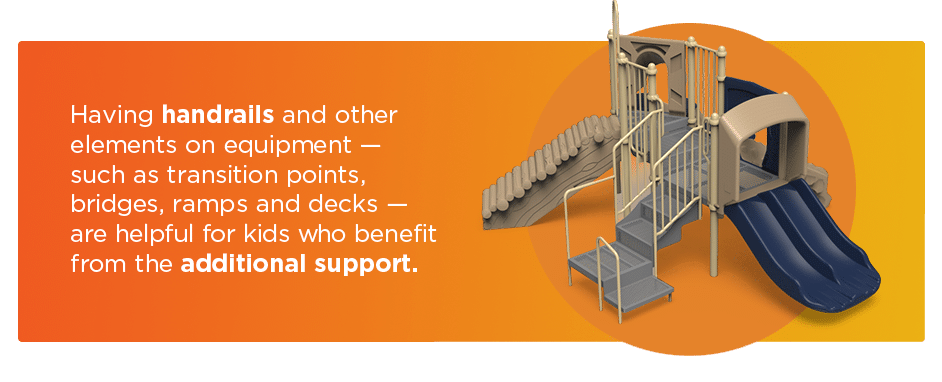
Pieces to Manipulate Materials
Playgrounds are a great way to incorporate learning. Preschoolers can have fun during play while discovering more about the world around them. Having low play tables that let preschoolers interact with sand, water and other materials is an easy way to get them excited about sensory play. You can add different structures and pieces to a playground to allow for manipulating materials in various ways.
These manipulatives can help kids learn to identify objects and colors around them and instill a love of nature.
Slides
Slides are an exciting feature of any playground. However, all slides on a playground intended for preschoolers should have hoods to encourage them to sit down correctly before they go down the slide. These hoods also help discourage preschoolers from trying to climb, stand or walk down a slide. Your playground company will also need to consider the average height of preschoolers when designing the height and slope of a slide.
Fall Height
The fall height is the distance between the highest point of any playground equipment, activity or structure and the protective surface on the ground below. Your commercial playground team must determine the fall height to ensure that kids between the ages of 2-5 can play on structures that have height measurements intended for their age group and size. For preschoolers, the fall height would be shorter and smaller than equipment made for older, taller kids.
All equipment needs to be an appropriate height, level or distance that accommodates the hands, arms, feet and legs of preschoolers. This ensures they can play without overexerting themselves.
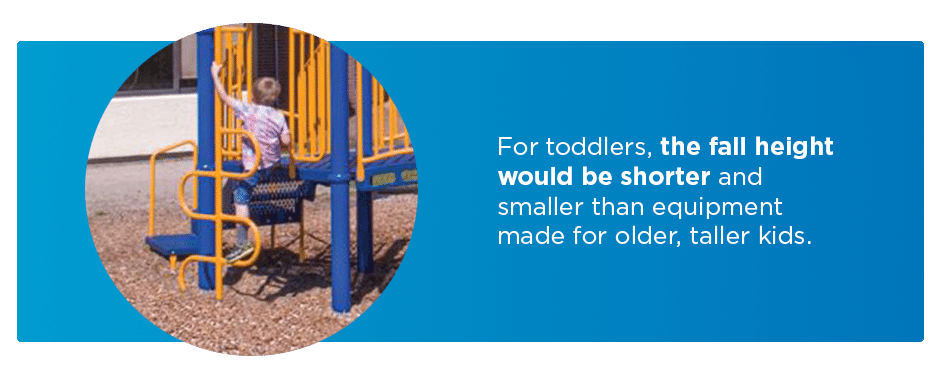
Sightlines
Free, unstructured play is essential to let kids explore and gain a sense of independence. However, safety is one of the most important elements of any playground. It is essential to ensure that caregivers can see all kids as they navigate the playground environment and interact with others. Kids can easily try to push the limits and attempt something outside of their physical abilities. The layout of your playground should allow for adults and caregivers to step in, supervise and have clear vision of all kids at all times.
This means all playground equipment and structures should have minimal barriers and allow easy access for adults to maneuver and have continual sight of preschoolers on the playground.
Preschool Playground Equipment Options
There are many different types of equipment that preschoolers can enjoy on a playground. When you picture age-appropriate equipment for preschool play areas, you may think of slides or a sandbox, but there are so many other options. Between the ages of 2-5, preschoolers have a wide range of physical capabilities — which different playground options can accommodate.
Providing different playground equipment options can help stimulate brain activity and make preschoolers excited about spending time outdoors. Here are some preschool playground equipment ideas.
Merry-Go-Rounds
Merry-go-rounds are a thrilling activity to help kids develop their fine and gross motor skills. This rotating equipment, which has evolved into modern-day spinners, is also beneficial for preschoolers to interact with others as multiple kids can use it at once. Kids can play, socialize and laugh together as they spin through the air and feel the exciting sensation of the breeze. Merry-go-rounds are equipped with various handholds that let preschoolers exercise their coordination and learn to practice balance.
Kids can play around with the momentum and the feel of whirling around, letting them enjoy the effects of gravity. Additionally, since this equipment is close to the ground, it provides an appropriate level of difficulty for preschoolers. However, you should always monitor preschoolers on moving or spinning equipment to ensure they are using it correctly.

Swing Tot Seats
Like slides, swings are an integral, exciting part of any playground. For toddlers and preschoolers, swing tot seats are the perfect variation to this classic equipment. Bucket seats allow smaller kids to enjoy the motion and sensation of swinging through the air without having to rely on balance and core muscles as much. Swings are a great way for preschoolers to develop their vestibular system as they learn about their bodies through movement and gravity.
Preschoolers can also get a taste of sensory play in this activity as they feel the wind and grasp the seat or swing chains to help move them through the air. Though kids in the 2-5 age range may not be ready for U-shaped belt swings yet, these bucket swings will certainly teach them how to pump their legs. This is an essential movement that they can use as they grow bigger and become ready to take on new challenges on the playground.
Spring Riders
Between the age range of 2-5, preschoolers are working on their balance and coordination. While they may not be ready for more difficult equipment, such as balance beams, there are plenty of other ways that they can practice these skills and movements. Spring riders are a fun way for preschoolers to use physical capabilities in an age-appropriate way. Spring riders and bouncers incorporate sensory play as kids hold onto handles as they bounce up and down or rock back and forth.
There are many different themes for spring riders, such as spaceships, animals, airplanes and various vehicles. Twin riders are also a great way for preschoolers to play together and encourage social engagement. These spring riders let two kids sit and operate the movement together, helping them learn how to share and cooperate to achieve a fun goal.
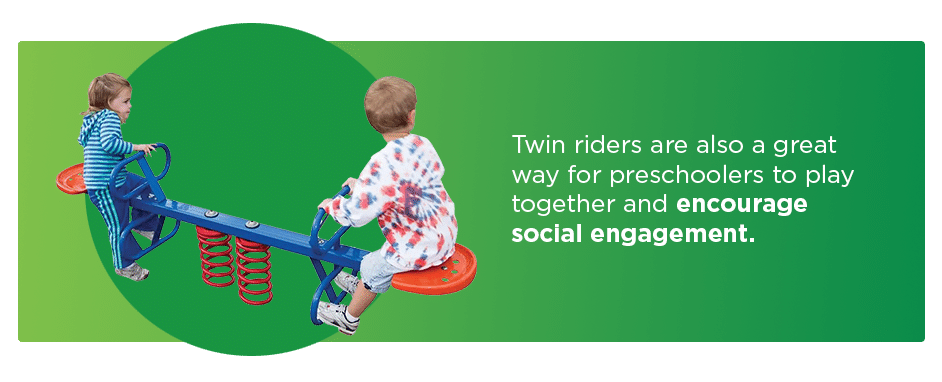
Sensory Equipment
Sensory play is an invaluable method of teaching kids how to interact with the world around them through their senses. Preschool-aged kids may not have advanced skills or balance yet to navigate certain larger structures, so sensory play is the perfect age-appropriate equipment for them. Sensory play is essential to cognitive and physical development in preschoolers because it encourages them to respond to noise and learn the difference between textures.
On a playground, there are many different types of sensory equipment, such as tactile, auditory and educational panels. Some of these panels include different shapes, sounds and music or movements that can be freestanding or part of a fun sensory maze. This playground equipment for ages 2-5 offers multi-sensory play experiences that enable preschoolers to engage with their visual, hearing, touch and vestibular senses.
These activity panels are perfect for make-believe, social and role play, which are essential for emotional development in young kids. Sensory equipment can also help boost creativity and curiosity while inspiring kids to learn.
Freestanding Structures
Freestanding components allow for even more creativity as kids can engage in imaginative play. These structures could include spring riders and bouncers, animal hoppers or sculpted play elements. While playing during these activities, preschoolers learn to use their bodies in different ways and use various muscle groups. Themed playhouses that include various city elements, such as trucks, houses and gardens, can allow kids to imitate others and learn how adults may use those structures in their daily life.
Crawl tunnels are also a fun option for preschoolers to incorporate physical activity or even take a break from play and practice social interaction.
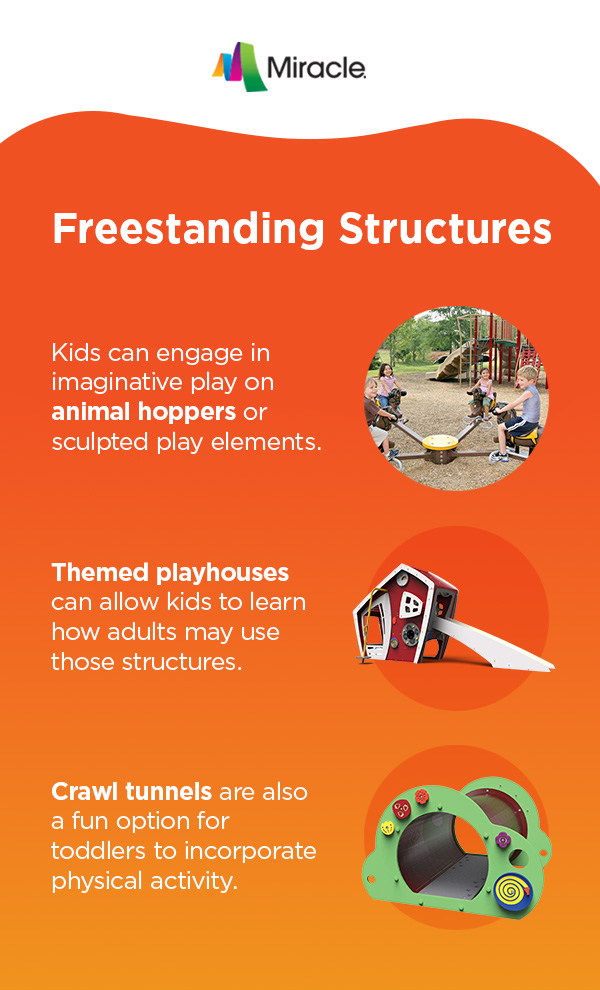
Complete Structures
If your school or organization has a wide age range and a large number of kids, consider investing in complete structures for your playground. These structures are often larger than freestanding equipment because they provide multiple activities in one central design. However, complete structures are also beneficial if you only have needs for a toddler playground, specifically.
Complete structures made for preschoolers have more comfortable and accessible features for smaller hands and feet. They also include varying levels of difficulty to encourage minor but meaningful challenges. These structures have many exciting features, such as double slides and colorful climbing walls to access different platforms. Complete structures for preschoolers can also come with tactile elements that encourage kids to touch and interact with different textures and parts.
While there are many options for complete structures, they all vary in design, color, layout, amenities and detail. These structures also vary in size to accommodate many different interests. Little tots may benefit from smaller playground structures while those in the upper preschooler age range may particularly enjoy larger or more detail-oriented themed structures.
How to Select Playground Equipment for 2 to 5-Year-Olds
Now that you know more about age-appropriate playground equipment for preschooler-level kids, there are some additional aspects to think about when selecting options for your layout. While some playground designs may be appealing to you, they may not be the best fit for the size of your location or the number of kids that will often be playing on the equipment. Additionally, there are various benefits to choosing different types of structures or freestanding equipment, depending on many factors during the decision-making process.
Here are some important elements to take into account when choosing preschool playground equipment.
Become Familiar With ADA Requirements
There are certain height and measurement requirements that can impact your playground, but there are also accessibility and licensing requirements. The Americans with Disabilities Act (ADA) has specific mandates and guidelines for public playground equipment, such as ramps, pathways and other means of access for different structures, platforms and activities. These requirements incorporate the functions of those who have mobility devices and special needs.
Audit Existing and Future Needs
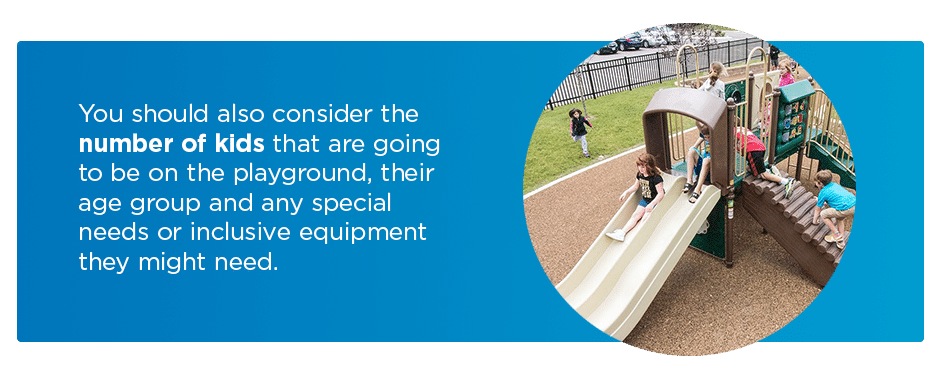
The size and location of your potential or existing playground may work for now, but what about in a few years? Think about how your location needs may change. For instance, if your playground is meant for a school, does your school plan to expand? Perform a needs assessment for your playground to determine some factors like size, space and layout.
You should also consider the number of kids that are going to be on the playground, their age group and any special needs or inclusive equipment they might need.
Determine Your Budget
The budget for your playground includes the equipment itself, site preparation, professional installation and more. However, if your budget is restricting you from getting the playground size and capability you need, consider fundraising to get the community involved. Other funding options are also available to help you build an innovative, immersive playground that fits your location, size and age-group needs.
Research Your Options
There are endless options for custom, freestanding, themed and complete structure playground equipment for preschoolers. Do your research to find the best options that work for your school’s color scheme, size and number of kids. Playgrounds are an integral part of any school or public area, so take the time to look at different elements and solutions that fit your needs.
Many colors, styles, combinations and sizes of pre-designed equipment are readily available, but you can invest in custom playground equipment for a unique play experience. You can also consider adding site amenities to outfit the entire area and create a truly immersive atmosphere for everyone.
Other Considerations for Selecting Preschool-Level Playground Equipment
Designing and adding a playground to your school, daycare, park or other public location is a detailed process. You must implement all of the necessary elements in the creation and installation process to ensure that kids of all ages have appropriate equipment for their height and physical capabilities. In addition, adults and caregivers that are supervising should separate large age groups to the proper equipment to accommodate all kids.
Because playgrounds are so important for entertainment and physical activity, think about a few other areas that might influence your choice of equipment:
- Age separation: It’s a good idea to keep equipment meant for older kids away from toddlers or preschoolers. They may wish to join the older kids on equipment that is not built for their height and capabilities, which can make them feel frustrated. In addition, it’s not safe for young kids to play on equipment that doesn’t meet their height measurements or fall height requirements. However, if your school or daycare encompasses many different age groups, you can consider choosing equipment that any kids from ages 2-12 can use.

- Playground surface: The playground surface that is under the equipment plays a significant role in safety and mobility. Shock and energy-absorbing materials are frequently used as playground surfacing. Though loose-fill materials are common for playgrounds, you should not use them in an area meant for preschoolers because they present a choking hazard. Instead, unitary surfacing materials, such as poured in place rubber, are best for preschool-aged kids.
Bring the Thrill Back Into Playgrounds With Miracle Recreation
At Miracle, we value quality, durable playground equipment for the physical and social development of all kids. We want to ensure preschoolers have a fun, joyful experience playing outdoors while learning essential skills and interacting with others. You can bring these opportunities to your school or daycare with playground equipment designed to thrill. We carry a wide selection of themed, custom and freestanding equipment for all of your playground needs.
If you are looking for a playground that includes all age groups, our complete playground structures will be sure to engage all kids for active, exploratory play. We are proud to offer many different options that fit your space and budget while encouraging kids and adults to value outdoor play. We can’t wait to partner with you and design the playground of your dreams. Contact us today.

